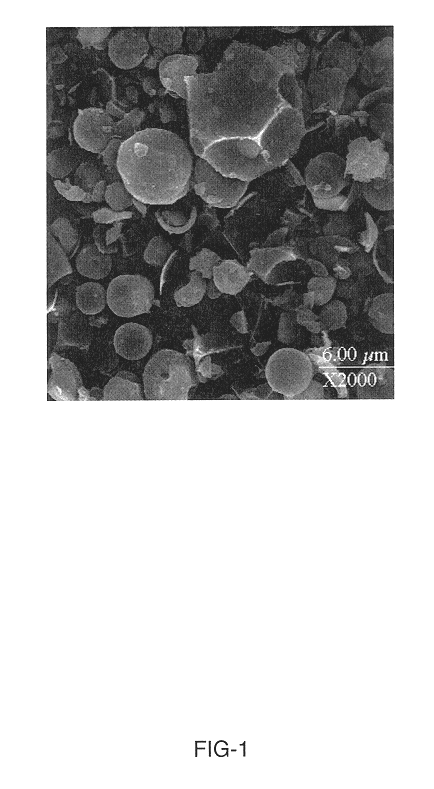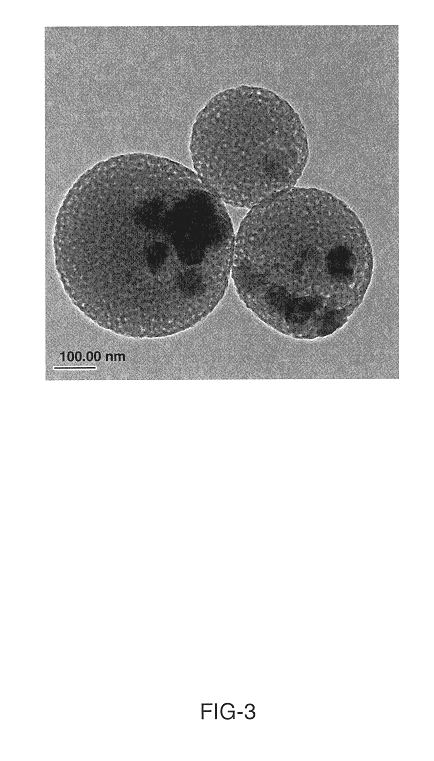Synthesis of attrition-resistant heterogeneous catalysts using templated mesoporous silica
a technology of mesoporous silica and catalyst, which is applied in the direction of catalyst activation/preparation, metal/metal-oxide/metal-hydroxide catalyst, physical/chemical process catalyst, etc., can solve the problems of attrition of catalysts, phase changes tend to stress and weaken catalysts during use, and the effect of catalyst attrition
- Summary
- Abstract
- Description
- Claims
- Application Information
AI Technical Summary
Benefits of technology
Problems solved by technology
Method used
Image
Examples
example 2
The encapsulated material, prepared by EXAMPLE 1, was tested for its attrition using the ultrasonic fragmentation method. An approximately 0.05% by weight sodium hexametaphosphate (SHMP; Aldrich) solution was prepared by mixing approximately 0.5 g of sodium hexametaphosphate with approximately 1000 ml of deionized water. In a typical run, approximately 1.0 g of a catalyst sample was added to approximately 50 ml of the approximately 0.05% by weight SHMP solution which was used as a dispersing agent. A Micromeritics Sedigraph 5100 analyzer was used to initially measure the particle size distribution at approximately 0 min. Using a Tekmar 501 ultrasonic disrupter (20 kHz+50 Hz) equipped with a V1A horn and a 1 / 2 probe tip, the suspension was subjected to ultrasonic energy at an amplitude setting of 20 (100 W) at approximately 5-min intervals, up to approximately 25 min. After different extents of ultrasonic irradiation, the particle size distribution was analyzed to detect the mode of ...
example 3
The encapsulated material, prepared by EXAMPLE 1, was tested to determine the extent of reducibility in H.sub.2. In a typical run, approximately 25 mg of sample was added to a U-tube used for our reactor system. The sample was initially degassed in He at approximately 200.degree. C. for approximately 1 hr to remove moisture or contaminants adsorbed on the surface of the sample, and then cooled back to room temperature. The catalyst was heated in H.sub.2 from approximately 25.degree. C. to approximately 300.degree. C. at a rate of approximately 10.degree. C. / min, and was reduced at approximately 300.degree. C. overnight.
In order to passivate the sample, it was initially purged in He at approximately 300.degree. C. for approximately 30 min and cooled to room temperature. A very small amount of O.sub.2 was introduced in the flowing He (<1% O.sub.2 in He). The oxygen was then gradually increased to a final concentration of approximately 20% O.sub.2 in He in order to simulate atmospheric...
example 4
The following example describes the phase transformations that an iron oxide particle undergoes as it is activated for a Fischer-Tropsch synthesis process. Approximately 1 g of a pure iron oxide (promoted with Cu and K) catalyst was loaded into a U-tube reactor. The catalyst was treated in approximately 20 sccm of H.sub.2 at approximately 270.degree. C. for approximately 2 hours. Fischer-Tropsch synthesis was carried out at a H.sub.2 / CO ratio of approximately 0.7 at approximately 250.degree. C. The CO contained approximately 3% Argon as an internal standard to allow quantitation of the reaction products using a gas chromatograph equipped with a thermal conductivity detector. After reaction, the catalysts were removed from the reactor after careful and highly controlled passivation. This involved purging with Helium at the reaction temperature, cooling the sample to room temperature, and exposing it to small amounts of O.sub.2 in a stream of flowing Helium till a final O.sub.2 conte...
PUM
| Property | Measurement | Unit |
|---|---|---|
| pH | aaaaa | aaaaa |
| diameters | aaaaa | aaaaa |
| diameters | aaaaa | aaaaa |
Abstract
Description
Claims
Application Information
 Login to View More
Login to View More - R&D
- Intellectual Property
- Life Sciences
- Materials
- Tech Scout
- Unparalleled Data Quality
- Higher Quality Content
- 60% Fewer Hallucinations
Browse by: Latest US Patents, China's latest patents, Technical Efficacy Thesaurus, Application Domain, Technology Topic, Popular Technical Reports.
© 2025 PatSnap. All rights reserved.Legal|Privacy policy|Modern Slavery Act Transparency Statement|Sitemap|About US| Contact US: help@patsnap.com



